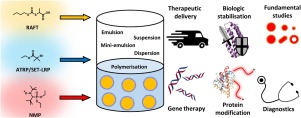Progress in Polymer Science ( IF 27.1 ) Pub Date : 2020-01-13 , DOI: 10.1016/j.progpolymsci.2020.101209 Pratik Gurnani , Sébastien Perrier

|
Polymeric nanoparticles show great promise in a range of biomedical applications, improving pharmacokinetic properties, dose requirements and immune response in drug delivery and bioimaging. Common synthesis techniques such as self-assembly, while prevalent, are unscalable and require the use of organic solvents, or extensive purification. In contrast, recent developments in dispersed state reversible deactivation radical polymerization allow the preparation of well-defined nanomaterials in fully aqueous environments often achieving full monomer conversion, and thus direct use in biological environments without purification in high quantities. These techniques have allowed the preparation of a variety of nanoparticle architectures (nanogel, latex, micelle, nanoworms, vesicles), using ATRP, RAFT and NMP, which in many cases perform significantly better than free radical alternatives. This review focuses on the biological relevance of RDRP in dispersed systems, covering miniemulsion, dispersion, suspension and emulsion polymerizations.
中文翻译:

用于生物应用的分散系统中的受控自由基聚合
聚合纳米颗粒在一系列生物医学应用中显示出巨大的希望,它可以改善药物代谢动力学特性,剂量要求以及药物输送和生物成像中的免疫反应。常见的合成技术(例如自组装)虽然普遍存在,但却无法扩展规模,并且需要使用有机溶剂或进行大量纯化。相反,分散状态可逆失活自由基聚合的最新进展允许在完全实现单体完全转化的完全水性环境中制备明确的纳米材料,从而无需大量纯化即可直接用于生物环境。这些技术允许使用ATRP,RAFT和NMP制备各种纳米颗粒结构(纳米凝胶,胶乳,胶束,纳米蠕虫,囊泡),在许多情况下,其性能要比自由基替代品好得多。这篇综述着重于分散体系中RDRP的生物学相关性,涵盖了细乳液,分散,悬浮和乳液聚合。


























 京公网安备 11010802027423号
京公网安备 11010802027423号